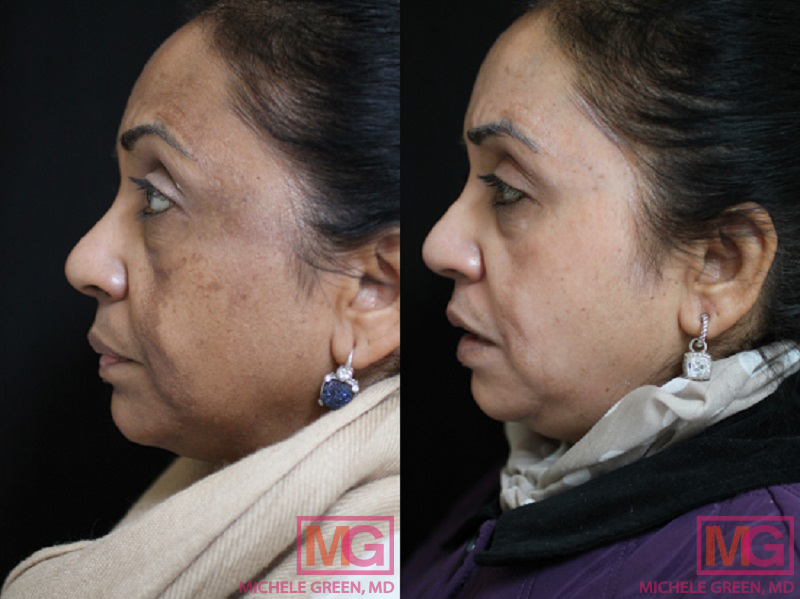Sunspots for Skin & Sunspot Removal Treatment
How to Remove Sunspots on Your Skin
Throughout our lives, we are frequently overexposed to the sun’s rays. Going outside without protective layers of clothing, a wide-brimmed hat, or sunscreen can leave our skin exposed to UV radiation, which, over time, can cause dark spots to form on our skin. The development of sunspots or brown spots on the skin is very common and completely harmless; however, having these signs of aging visible on our bodies can feel distressing. Luckily, many dermatological treatments are available to permanently eliminate sunspots, including laser treatments, intense pulsed light, chemical peels, etc. When navigating the treatment options, it is best to make an appointment with a specialist in cosmetic dermatology, such as Dr. Michele Green in NYC, who can help develop a treatment plan that suits your specific concerns and aesthetic goals.
Sunspots, also known as age spots, are flat, brown spots that form on the parts of the body that are most frequently hit by direct sunlight, including the face, shoulders, arms, and hands. Repeated ultraviolet light exposure stimulates pigment cells to increase melanin production, which causes increased skin pigmentation and sunspot formation. While increased melanin production is a protective measure to prevent our skin from burning, it has the unfortunate side effect of creating new sunspots, brown spots, and dark spots on the face and body. Sunspots will not go away on their own and require some form of intervention to get rid of them. Dr. Green employs a wide variety of laser treatments, chemical peels, and topical skincare products to remove sunspots permanently for a clear, beautiful complexion.
Dr. Michele Green is an expert in treating sunspots, discoloration, and other hyperpigmentation disorders in her private NYC Upper East Side office. A world-renowned, board-certified dermatologist, Dr. Green is uniquely skilled at removing sunspots and facial pigmentation and is always on the cutting edge of safe and effective treatments, including lasers such as the Alex-Trivantage, Fraxel, and Clear+Brilliant and chemical peels such as the Cosmelan and Mesopeel. She is consistently rated as a top dermatologist in New York City by Castle Connolly, New York Magazine, Super Doctors, and The New York Times due to her expertise and dedication to her patients. If you are tired of the appearance of facial or body discoloration, sunspots, or age spots, Dr. Green will create a customized treatment plan for you, incorporating the best treatments and skincare to help you achieve and maintain even, beautiful, clear skin.
What are sunspots on the skin?
As we age, the effects of frequent unprotected sun exposure begin to show on our skin in the form of sunspots. Sunspots are characterized by flat, brown spots that vary in size and shape and develop most frequently on the face, shoulders, arms, and hands. The term sunspot has become synonymous with other terms such as age spots and liver spots, though these spots that appear have nothing to do with the liver. Sunspots are extremely common but tend to affect people over the age of 40 more frequently. Sun spots or age spots are due entirely to the degree of sun damage you have sustained during your life and your genetic predisposition to producing these dark spots. Increased sun exposure increases the number of sunspots and depth of pigmentation. Sunspots are harmless, but unlike freckles, they do not fade over time and can only be eliminated through a dermatologic treatment, such as chemical peels or lasers.
What do sunspots on the skin look like?
Sunspots are flat areas of skin discoloration that can be light tan, brown, or varying shades in between. Sunspots do not have any texture and can appear on any part of your body that has been exposed to the sun, including your face, neck, décolletage, shoulders, back, legs, and the top of your hands. Other terms for sunspots include liver spots, age spots, and solar lentigines.
Why do sunspots occur?
In childhood, repeated sun exposure leads to freckles in sun-exposed areas. As we age and are exposed to more sun, these freckles tend to coalesce and get darker and more prominent, resulting in sunspots. A history of repeated sunburns can additionally cause sunspots. These sunspots get deeper over time and are commonly found in sun-exposed areas such as the face, chest, neck, back, legs, and hands. In fact, sunspots on the hands are among the first visible signs of aging for many patients.
How do sunspots form on the skin?
Sunspots form due to intense or accumulated exposure to UV rays from the sun. These UV rays are absorbed into our skin and cause the melanocytes in that area to multiply. Melanocytes are the pigmented skin cells responsible for the production and transfer of melanin, which is the chemical in our bodies that gives our skin pigmentation. Through repeated exposure to the sun, the melanin in the skin comes together to create a dark spot on the skin. The purpose of melanin in the body is to absorb UV rays and protect the DNA in our skin. Thus, sunspots occur on the body to protect us. However, the discoloration on the skin can be a distressing sign of aging.
When is it time to consult a dermatologist to evaluate your sunspots?
Spots that appear on our bodies as we age can be alarming, as they can be an early sign of skin cancer. Cancerous spots can develop due to harmful UV rays from the sun or tanning beds. Therefore, it is very important to have spots evaluated by a dermatologist when you notice them developing on your body. Skin cancer is very common – 1 in 5 Americans is likely to develop skin cancer before they are 70, according to research released by the Skin Cancer Foundation. However, not all spots that develop over time are precancerous. In fact, sunspots are not dangerous at all and need only be removed for cosmetic reasons. When you discover a spot, it can be challenging to tell the difference. Some signs of cancerous growth are dark spots or moles that are new, growing, or changing or that contain irregular borders or asymmetry. If you are uncertain about a new or changing mole on your body, a board-certified dermatologist, such as Dr. Michele Green, can assess the lesion and determine if it is a harmless sunspot or abnormal cancerous growth.
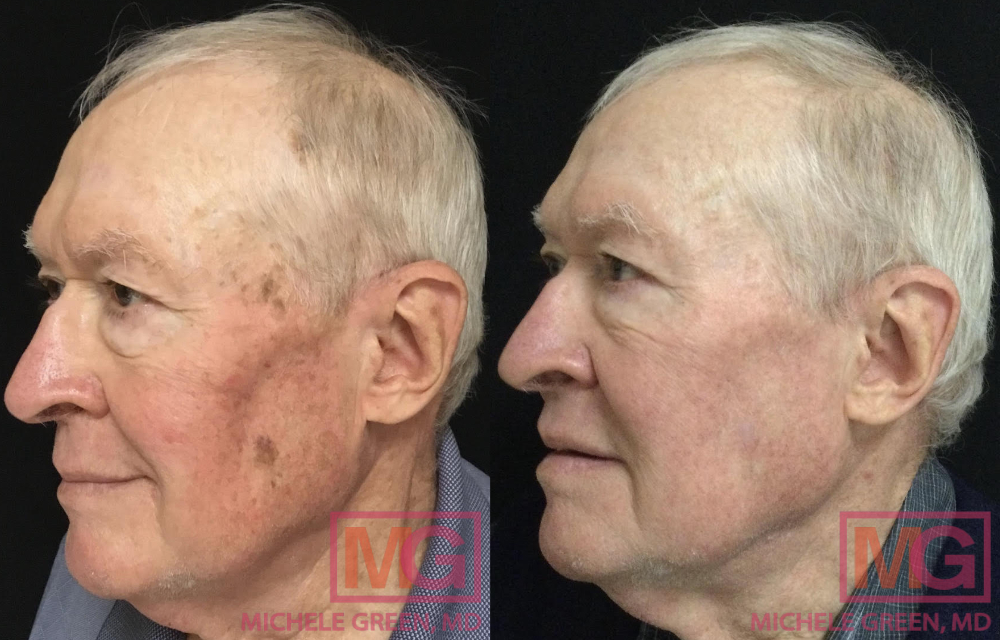
AlexTrivantage laser and Fraxel before and after
How to remove sunspots on your skin
In the past, cryotherapy using liquid nitrogen was a popular treatment option for sunspot removal; however, cryotherapy can cause significant skin irritation and tissue damage and is not typically used anymore. Today, there are many different techniques used for removing sunspots, including laser treatments, chemical peels, Cosmelan peels, microneedling, and over-the-counter creams. These treatments can work on various treatment areas, including the face, neck, scalp, hands, arms, legs, back, chest, and décolletage. An expert like Dr. Green can remove sunspots in virtually any area of the body and uses a combination of treatments based on the distribution of your sunspots and skin tone.
Patients with Fitzpatrick type I and II skin types are generally treated with different lasers and methods than patients with darker type III through type V skin. Choosing the right laser based on skin tone and severity of sunspots is fundamental to having the best cosmetic results. For many of these sunspot treatments, removal is permanent so long as you avoid further exposure to the sun’s harmful UV rays and always wear sunscreen or protective clothing, including sunglasses and a wide-brimmed hat. When you have your initial consultation with Dr. Green, the two of you will work together to determine the best treatment option or a combination of treatments to eliminate your sunspots and leave you with clear, beautiful skin that lasts.
Candela Alex-Trivantage laser to treat sun spots
The Candela Alex-Trivantage Laser is a Yag laser designed to treat discreet sun spots. The laser works by emitting wavelengths of light that are absorbed by the pigment in the dark spots on the skin. These melanin-rich lesions transform the light energy into heat, which eliminates the pigmentation and stimulates the production of new, lighter, healthier skin cells. The laser specifically targets the pigmentation in the skin, meaning that the skin tissue surrounding the sunspot is unaffected by the laser treatment. The Candela Alex-Trivantage laser treatment results can be seen in one to two weeks following the procedure. While patients typically need between one and two treatments to produce the best results, the number of treatment sessions required to achieve desired results will depend on the severity of the pigmentation. In addition to treating sunspots and age spots, the Alex-TriVantage laser can also remove tattoos, including black, blue, red, and green tattoo pigments.
Fraxel laser to remove sun spots
Fraxel laser was the first FDA-approved fractionated laser to treat sun damage, sun spots, texture, stretch marks, actinic keratoses, acne scars, fine lines, and wrinkles. The Fraxel® laser works by resurfacing a “fraction” of the skin, leaving the remaining skin unaffected to minimize downtime and accelerate healing. Fraxel laser creates “micro-injuries” on the skin, triggering new collagen formation and bringing healthy, unpigmented cells to the skin’s surface. The Fraxel Dual operates on two wavelengths of light: the 1927 nm, which treats predominantly pigmentation and sun damage, and the 1550 nm, which treats fine lines, wrinkles, and acne scars. A combination of the two settings can be utilized to treat both conditions simultaneously, reducing sun spots and wrinkles and improving skin texture, all with only a few days of recovery. Several sessions of Fraxel should be scheduled to remove sun damage and give you the best cosmetic results. Dr. Green recommends scheduling three treatment sessions for the ultimate treatment, each spaced a month apart. The Fraxel laser is best used to treat lighter skin tones. Patients with darker skin tones who are looking for laser treatment can look to the Clear + Brilliant Laser, which Dr. Green also uses in her office.
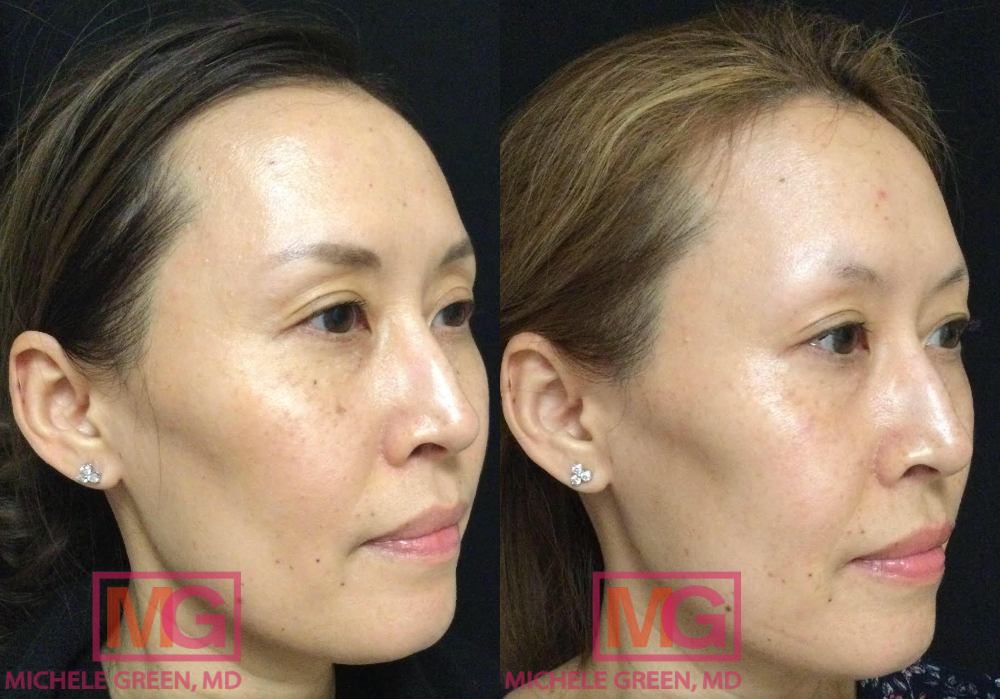
42 year old female before and after sun spot treatment with AlexTrivantage laser
Clear + Brilliant Laser for sun spots
Clear + Brilliant laser is commonly called a “mini-Fraxel” laser. Clear + Brilliant is a gentle laser resurfacing treatment that was FDA-approved in 2011. By using fractionated laser technology, Clear + Brilliant creates millions of microscopic treatment zones in the face, stimulates new collagen production, removes dead skin cells, and produces healthy new skin. Clear + Brilliant treats all over sun damage, sunspots, uneven skin tone, irregular skin texture, fine lines, and enlarged pore size. Patients of all skin tones, including darker complexions, can benefit from Clear + Brilliant laser treatment for total facial rejuvenation. Immediate improvement is noted after just one laser treatment, with continued improvement with each subsequent Clear + Brilliant session. Five treatments spaced one month apart are typically recommended for optimal results. There is zero downtime associated with the Clear + Brilliant laser, making it an excellent option for removing sunspots and producing beautiful, younger-looking skin.
Intense Pulsed Light (IPL) for pigmentation and sun damage
The Intense Pulsed Light (IPL) laser treatment, or photo facial, reduces unwanted pigmentation, facial redness, fine lines, and skin laxity to improve the overall color and texture of the skin. Intense Pulsed Light differs from laser resurfacing in that while lasers typically use a single wavelength of light, IPL lasers use several different wavelengths of light to treat various skin conditions. The flash of light emitted from the IPL device travels to the dermal layer of the skin to destroy the melanin-rich cells in the sunspot. The photo-facial (IPL) procedure is quick and effective, with minimal discomfort and no downtime. However, Dr. Green recommends that you continue to avoid sun exposure as much as possible and wear sunscreen and protective clothing, such as a wide-brimmed hat, whenever you are outdoors.
Cosmelan peels to treat sun damage and sun spots
Cosmelan is a professional-grade chemical peel treatment available in the office of Dr. Michele Green, which contains a proprietary combination of active ingredients to produce extremely effective skin-lightening results. The applied Cosmelan Peel mask works by multiple mechanisms to dispel the pigmentation in the affected areas and prevent further accumulation of melanin. This specialized chemical peel removes dead, pigmented cells from the skin, reveals healthy, clear skin cells, and inhibits pigmented cells from moving to the epidermis (the top layer of the skin). During your appointment, Dr. Green will apply the Cosmelan Peel to the affected area of the skin. The amount of time the mask must be worn will be determined based on the severity of the sunspots, pigmentation, or melasma and the location of the pigmentation. Patients will then remove the mask at home with a gentle cleanser. Following the treatment, Dr. Green may prescribe a skincare routine with creams from her MGSKINLABs, enhancing the treatment results and protecting your skin from further skin pigmentation. Creams may include active ingredients such as Kojic acid, azelaic acid, hydroquinone, and hydra-vital factor K. Dr. Green also recommends strict sun avoidance following the treatment to avoid any further damage by the UV light in the sun’s rays. If you must be out in the sun, Dr. Green recommends a combination of chemical and physical sunscreens for the best protection.
Mesopeels for pigmentation under the eyes and body
Mesopeels are a type of chemical peel available at Dr. Green’s office specifically designed to treat more sensitive areas of the skin. The four critical active ingredients – 20% Azelaic, 10% Resorcinol, 6% Phytic, and 3% Tranexamic Acid – work together to gently exfoliate the skin and stimulate the production of new collagen. The exfoliation eliminates the pigmented cells, while the stimulation of collagen production triggers the growth of smoother, lighter, and brighter skin cells. The Mesopeel is designed to treat hyperpigmentation around various body parts, including the face, neck, back, and axilla. Another type of Mesopeel, the Mesopeel Periocular, is specifically designed to lighten the dark under-eye circles. Mesopeels are best used to treat sensitive areas with no discomfort or recovery time. A series of Mesopeels should be scheduled every two to three weeks, with the full cosmetic results evident after six peels. Patients must avoid significant sun exposure by wearing chemical and physical sunscreens, clothing that covers the skin (like a wide-brimmed hat), or staying indoors between 10 am and 3 pm when the sun is at its peak.
Chemical Peels to remove sunspots
Chemical peels involve applying a chemical solution to resurface the skin, exfoliating the treatment area, and removing the top layers of dead skin to reveal healthy, lighter skin underneath. In addition to treating pigmentation, chemical peels are excellent for reducing the appearance of fine lines, skin texture, and pore size. Dr. Green employs a variety of proprietary chemical peels, which contain glycolic acid, an alpha hydroxy acid, and trichloroacetic acid, for the best results in eliminating sun spots. Chemical peels come in a variety of different strengths, and Dr. Green will determine if a light, medium, or deep chemical peel is necessary based on the severity of your sun damage. The number of chemical peels required to achieve ideal cosmetic results can vary depending on your skin tone and the skin concern to be addressed. Side effects of the peel can include redness and flaking that generally resolve in a few days after the peel. Typically, a short series of chemical peels, each spaced approximately four weeks apart, will renew your skin and remove your dark spots. You will notice a visible improvement after even just one peel. However, the best cosmetic results are obtained after a series of chemical peels are performed since it takes time to reverse years of sun damage.
HydraFacials for skin brightening
A HydraFacial is a three-step, medical-grade facial often paired with boosters (specialized serums) to remove facial pigmentation, acne, and facial redness. The HydraFacial, performed at Dr. Green’s office, begins with the cleansing phase, entailing the removal of dead skin cells from the skin’s surface while simultaneously hydrating the skin. Once the skin has been cleansed, the second step in the process is exfoliation. The exfoliating step is often compared to microdermabrasion, though the processes differ in their exfoliating technique. During a HydraFacial, the skin is exfoliated with a proprietary vortex suction machine with a specially designed tip to remove dead skin cells and dirt. Finally, step three involves rejuvenating the skin with serums and moisturizers. The Hydrafacial can be enhanced with boosters or specialized serums to address specific skin concerns, such as redness, skin tone, pigmentation, and fine lines. Dr. Green employs custom-designed skincare treatments to revitalize the skin and leave you with a young, fresh face free of pigmentation.
Microneedling with skin depigmentation solution
Microneedling, or collagen induction therapy, is an excellent skin rejuvenating treatment option that can be paired and enhanced with skin-lightening serums to treat sunspots and skin pigmentation. Microneedling uses tiny, insulated surgical-grade needles to create micro-injuries in the epidermal layer of the skin. The pricks of the needles trigger the body’s healing response, producing new collagen and healthy skin cells to decrease the appearance of sun spots, improve skin texture, and treat acne scars. For patients most concerned with addressing hyperpigmentation, whether it be in the form of sun spots, melasma, or pigmented acne scars, incorporating a depigmenting serum into your microneedling treatment provides exceptional results. The depigmenting serum is a unique blend of effective yet gentle skin-brightening agents that work against melanocytes in the skin (the skin cells responsible for creating pigment) to eliminate sun spots and pigmentation effectively. The microneedling procedure itself is quick, simple, and painless, and Dr. Green typically recommends that patients engage in 3 to 5 treatment sessions to achieve healthy, radiant, clear skin.
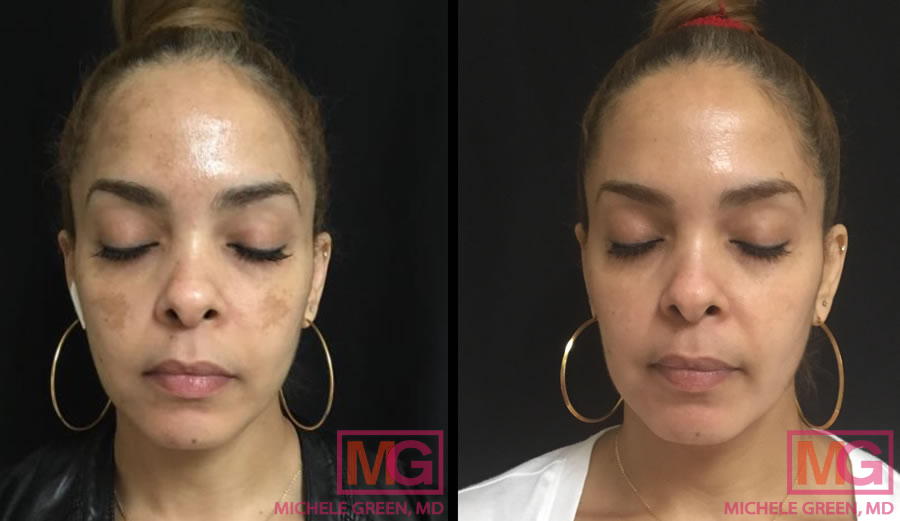
Microdermabrasion for discoloration
Microdermabrasion is a non-invasive treatment that gently removes the outermost epidermal layer of the skin to even out texture and eliminates discoloration and fine lines. The procedure exfoliates the skin using aluminum oxide crystals, removing dead skin cells and promoting the production of new, lighter skin cells in the treatment area. Results of the procedure are best achieved after several treatment sessions, each spaced about a month apart. Dr. Green will determine the treatment schedule that is best for you after considering the scope of the treatment area and the severity of your hyperpigmentation.
MGSKINLABs Skin Care Products
Founded by expert, board-certified dermatologist Dr. Michele Green, the MGSKINLABs Inc. line carries the best skin-lightening creams and lotions to treat sunspots. Dr. Green creates specific pigment protocol regiments for her patients, incorporating the safest, most effective topical creams, moisturizers, and cleansers for each skin tone and type. When you consult with Dr. Green on the best treatment plan to address your sunspots, she will recommend specific creams, serums, skin-lightening creams, and sunscreens from her MGSKINLABs line of products to best suit your unique needs. Each product is tried and true to effectively eliminate pigmentation and generate healthy, smooth, and bright skin.
First, Dr. Green recommends the use of a gentle cleanser. Skin lightening creams can irritate the skin, so Dr. Green recommends a mild lipid-free cleanser, which will clean your skin without drying it or producing further irritation. Rich moisturizers and hyaluronic acid serum are part of maintaining the proper skin balance and texture. Dr. Green may also recommend a topical retinol cream to help remove the discoloration and sunspots. Retinol, a vitamin A derivative, is essential for skin rehabilitation and works to exfoliate the skin, eliminate dead skin cells, and stimulate collagen production and healthy new, pigment-free skin.
Dr. Green may prescribe a hydroquinone or hydroquinone-free skin brightening cream. Hydroquinone is a topical skin-lightening agent that blocks the production of melanin and reduces melanin’s movement to the epidermis. Hydroquinone should be applied only under the direct supervision of a board-certified dermatologist, like Dr. Green, for optimal results. In conjunction with these creams, Dr. Green’s Vita C serum works to decrease unwanted discoloration of your skin, rejuvenates, and decreases unwanted redness as well.
The final, most crucial part of the pigment protocol to reduce sunspots and other forms of unwanted skin pigmentation is sunscreen. Dr. Green offers both chemical and physical sunscreen at MGSKINLABs Inc. When going through sunspot treatment, Dr. Green recommends doubling up on sunscreen and using both chemical and physical sunscreen. Chemical sunscreen absorbs UV rays to convert them into heat energy and emits them from the skin, whereas physical sunscreen sits on top of the skin and reflects the sun’s rays. A broad-spectrum sunscreen with an SPF of 50 is best for maximum protection from both UVA and UVB rays.
Hydroquinone-free lightening creams
Creams that contain hydroquinone are often considered the gold standard for skin lightening. However, a risk factor of this powerful treatment is skin irritation and redness in patients with sensitive skin types. Because of this sensitivity, Dr. Green often recommends creams and serums that contain tranexamic acid rather than hydroquinone. Tranexamic acid blocks the movement of melanin from the melanocytes, where it is created, to the epidermis. This movement of melanin is responsible for sunspots and other pigmentation in the skin. As a result, creams containing tranexamic acid rather than hydroquinone are still very effective in preventing sunspots and pigmentation when regularly applied. If you are unsure which lightening cream is best for you, Dr. Green will recommend the treatment plan that will be best for you during your initial consultation.
How long do sunspots last on the skin?
Unlike freckles, sunspots generally do not fade without any intervention. Laser treatments such as the Alex-Trivantage and Fraxel or chemical peels such as the Cosmelan or Mesopeel are safe and effective skin treatments for eliminating sunspots from the skin’s surface. After treatment, sunspot removal is permanent so long as you avoid excessive sun exposure, wear a hat and protective clothing, and continue usage of effective skincare products.
55-64 year old woman treated with Cosmelan & Chemical Peels
FAQs about Sunspots:
Is melasma the same as sunspots?
Melasma is a specific type of hyperpigmentation characterized by brown or brownish-gray patches of skin. Melasma can typically be found on the face across the forehead, cheeks, upper lip, and nose bridge. Like sun spots, melasma is caused by overexposure to UV rays, but it also has a hormonal association that is not seen in other types of hyperpigmentation. Pregnancy, hormonal replacement, and birth control pills can all worsen melasma. Women and patients with darker skin types are more prone to developing melasma, and many individuals with melasma find that they have a family history of melasma. Differentiating sun spots and melasma is critical, as they require completely different treatments. An experienced, board-certified dermatologist like Dr. Green can differentiate sunspots from melasma to help you choose an appropriate treatment plan for your skin condition.
Is melasma treatment different than sunspot treatment?
Many patients present to Dr. Green with recurring sunspots and discoloration, which have been treated with other lasers, such as Picosure, CO2, Erbium, Fraxel, and IPL, among others. However, upon close inspection, these patients have underlying melasma, which typically worsens with laser treatment. While laser treatment may temporarily improve the condition, melasma becomes much more difficult to treat as the pigmentation becomes deeper and more entrenched in the skin. For this important reason, Dr. Green recommends chemical peels, topical skin lightening treatments, Mesopeels, and Cosmelan peels for melasma, not laser treatment. Cosmelan is one of the best treatments to remove melasma and hyperpigmentation, including post-inflammatory hyperpigmentation or the worsening of their dark spots after laser treatment.
It can be hard to determine whether the pigmentation on your skin is melasma or sunspots, which is why working with an experienced board-certified dermatologist, such as Dr. Green, is critical. Dr. Green has over twenty-five years of experience providing some of the world’s most discerning individuals with the best non-invasive treatment options for hyperpigmentation, including melasma and sun spots. When you consult with Dr. Green, she will collect a thorough medical history, physically assess your skin condition, and develop a personalized treatment plan for your rejuvenation that best suits your needs and goals.
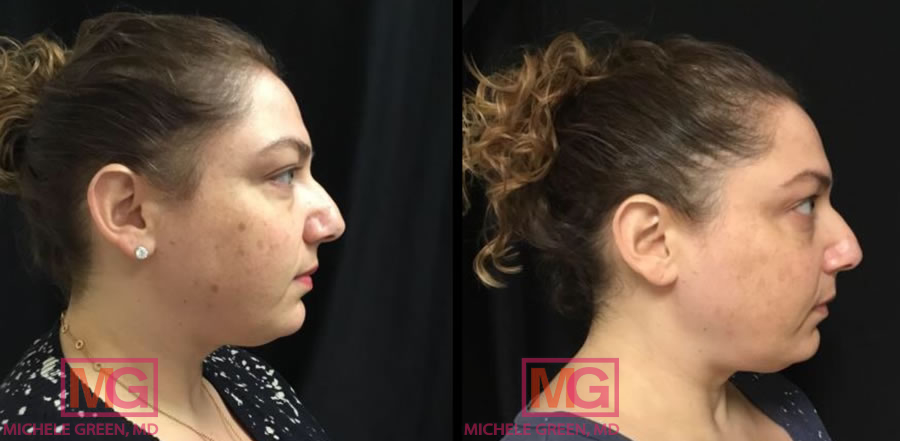
Will sunspots go away?
Unfortunately, sunspots do not fade or go away on their own. Sunspots result from sun damage, and removing them requires treatment by a board-certified dermatologist. With the advent of laser treatments and chemical peels, sun spots can be safely and effectively removed by an expert, such as Dr. Michele Green in NYC, with little or no downtime.
Can sunspots be cancerous?
No, sunspots are not harmful or cancerous and do not require medical intervention. They are a result of accumulated sun exposure and increased melanocytes and melanin pigment in the skin. While sunspots may be unsightly, they are completely harmless and cannot turn into skin cancer. Many patients choose to have sunspots removed for cosmetic reasons.
How can I tell if a dark spot is cancerous?
The American Academy of Dermatology uses the “ABCDEs” of skin cancer to determine if a dark spot may be cancerous. ABCDE stands for asymmetry, border, color, diameter, and evolving. Most melanomas are darker and have irregular borders, while sunspots and solar lentigines are typically smaller and more uniform in shape. Sometimes, it can be difficult to differentiate between a sunspot and skin cancer, as many types of skin cancers, such as actinic keratoses and basal cell carcinomas, can resemble sunspots. However, a board-certified dermatologist like Dr. Michele Green can recognize the difference between a benign and a malignant lesion. Skin cancer is on the rise today in the United States, and identifying and treating these lesions early is more important than ever. Careful examination of a dark lesion and biopsy may be indicated to be certain of the correct diagnosis and treatment. Dr. Green is a member of the American Academy of Dermatology and recommends yearly skin cancer examinations to diagnose, treat, and prevent skin cancer.
Can a sunspot turn into cancer?
No, sunspots or age spots are completely benign and do not turn into skin cancer. However, due to repeated sun exposure, patients with more sunspots are at increased risk for developing skin cancer. Sunspots are a warning that you have had too much sun exposure, which has caused damage to your skin.
Are white sunspots cancerous?
If you have white sunspots, you may be concerned that the hypopigmented skin areas lacking pigment are dangerous or cancerous. However, white sunspots are typically benign, and their appearance is no cause for concern. White sunspots are usually 1-3 millimeters in size and appear on the arms, legs, chest, back, and face. Most individuals with white sun spots are 40 years of age or above, although younger individuals with excess sun exposure may develop white sunspots, too. It is important to remember that any new or changing skin lesions should be evaluated by a board-certified dermatologist, such as Dr. Michele Green in NYC. Dr. Green can evaluate your skin condition and diagnose you accurately. Some white skin lesions are symptoms of other skin conditions that require treatment. For example, a common skin fungus called Tinea versicolor presents as a pale-colored rash that worsens with sun exposure. The Tinea versicolor rash is often mistaken for white sunspots. Dr. Green will assess the affected areas of your skin and develop a treatment plan according to your needs.
Are sunspots dangerous?
Sunspots on your skin are not dangerous. Sunspots are an indication that you have sustained a lot of sun exposure during your lifetime and are benign lesions. However, having received so much sun exposure is a risk factor for developing skin cancer during your lifetime. Dr. Green recommends annual skin cancer exams to ensure that you don’t have any skin cancers that need immediate diagnosis and treatment.
Do sunspots itch?
Sunspots do not itch and should not be painful or tender to the touch. If you have a dark spot that becomes itchy or irritated, it is best to consult with a board-certified dermatologist such as Dr. Green to receive appropriate treatment. Dr. Green can assess the skin lesion to determine if it is benign or if it warrants biopsy and further examination.
What can I do to avoid sunspots?
The best way to avoid sunspots is to practice proper sun protection and avoid unnecessary UV rays. Patients must use a broad-spectrum sunscreen with an SPF of 50 or higher to protect against both UVA and UVB rays. Dr. Green often suggests combining two different types of sunscreens, especially if there is a propensity for sunspots or melasma, to avoid developing sunspots and sun-related skin cancers. It is essential to apply sunscreen daily and reapply every 2 hours, especially after swimming or sweating. Individuals prone to sunspots or melasma should also wear protective clothing from the sun, including wide-brimmed hats, long-sleeved shirts, and sunglasses, and avoid the sun between the hours of 10 a.m. and 3 p.m. when it is strongest.
How much does it cost to remove sunspots?
The cost of removing sunspots varies depending on the type of treatments used, the number of treatment sessions required, and the extent of the sunspots and sun damage. When you make your consultation appointment with Dr. Green, she will assess the treatment area and determine the treatment plan that will work best for you. After that assessment has been made, her office can provide you with a better estimate of the total cost of the treatment.
How to treat sun spots at home
Various topical creams and ingredients can be added to your skincare routine to treat sunspots at home. Retinol creams and lotions containing alpha hydroxy acids such as glycolic acid help exfoliate the skin and fade sunspots. Vitamin C serum, like Dr. Green’s popular Vita-C-serum, has powerful antioxidant properties to lighten sunspots and repair the effects of damaging UV rays. Skin-lightening creams containing hydroquinones, kojic acid, arbutin, phytic acid, and azelaic acid all lighten the skin and diminish the appearance of sunspots and discoloration. Aloe vera has also been shown to lighten the skin and reduce the appearance of sunspots. Sunscreen is essential for ensuring that the skin is protected from further UV damage, which can worsen sunspots and create new ones. While topical products are effective for reducing the appearance of sunspots over time, typically, in-office treatments such as lasers and chemical peels are required to eliminate sunspots from the skin fully.
Where do sunspots occur?
Sunspots tend to develop on the areas of the body with frequent sun exposure, including the face, chest, backs of the hands, neck, arms, and shoulders. However, these harmless brown spots can develop anywhere on the body if there has been sun exposure. While sunspots won’t fade away or disappear on their own, they can completely diminish or eliminate their appearance with treatment options offered by board-certified dermatologist Dr. Michele Green in New York City. Dr. Green will assess the areas of your skin affected by sunspots, evaluate the severity of your hyperpigmentation, and develop a customized treatment protocol for achieving and maintaining clear, healthy, youthful-looking skin that lasts.
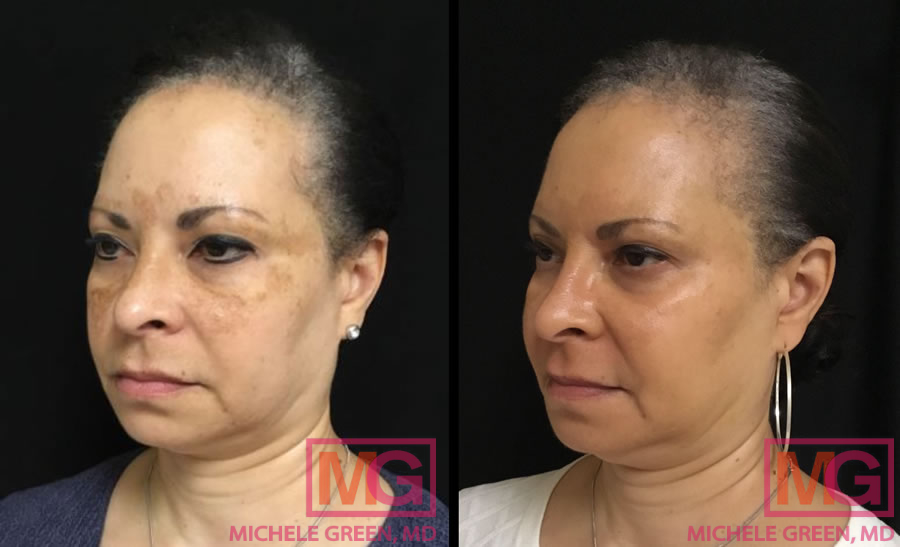
What do sunspots on the face look like?
Sunspots are smooth, flat, rounded areas of excess pigmentation that may be various shades of light tan to brown. Sunspots may resemble freckles, but they are usually larger and do not fade or go away on their own over time. Sunspots are commonly found in areas that get frequent sun exposure, including the nose and the rest of the face, as well as the chest, back, shoulders, arms, hands, and tops of the feet.
How to get rid of white spots from tanning
Sometimes, high amounts of sun exposure or tanning beds can result in hypo-pigmentation or the appearance of light spots on the affected area. White spots on the skin may occur for several reasons, and, as such, it is important to determine the cause of hypo-pigmentation to determine the best treatment method. One condition that can occur from too much sun exposure or tanning beds is Tinea versicolor. Tinea versicolor occurs when there is an overgrowth of yeast, called pityrosporum, on the skin’s surface. This yeast feeds on sweat, which can increase when you find yourself someplace sunny or humid. When it comes to tanning beds, bacteria can grow in the hot environment where many people are sweating, triggering pityrosporum growth on your own body. Tinea versicolor can typically be treated using an anti-fungal medication that can be prescribed upon diagnosis of the condition.
An underlying condition can also cause white spots made more apparent by tanning that occurs on the skin, such as Vitiligo. Vitiligo is believed to be an autoimmune disorder where white patches form on the skin, resulting from the production of melanin being stopped. When patients tan, the already present vitiligo becomes more visible in contrast with the darker skin of the tan. Several treatments can help reduce the disparity in coloration, such as corticosteroid creams and UVA or UVB phototherapy. If you are experiencing white spots on the surface of the skin, it is best to consult a dermatologist, such as Dr. Green, to get the correct diagnosis and best treatment plan for your condition.
How to remove liver spots
Liver spots are another name for sun spots, which occur due to overexposure to harmful UV rays. Excess exposure to the sun can cause the melanocytes in the body to increase melanin production in areas of your skin, which results in the formation of dark spots on the skin. Liver spots are harmless but can be a frustrating reminder of the natural aging process. Luckily, there are many options when it comes to liver spot removal. Laser treatment, chemical peels, intense pulsed light treatment, Hydrafacials, mesopeels, skin lightening creams, and microneedling are all treatment options available in Dr. Green’s Upper East Side dermatology office to remove liver spots from the skin.
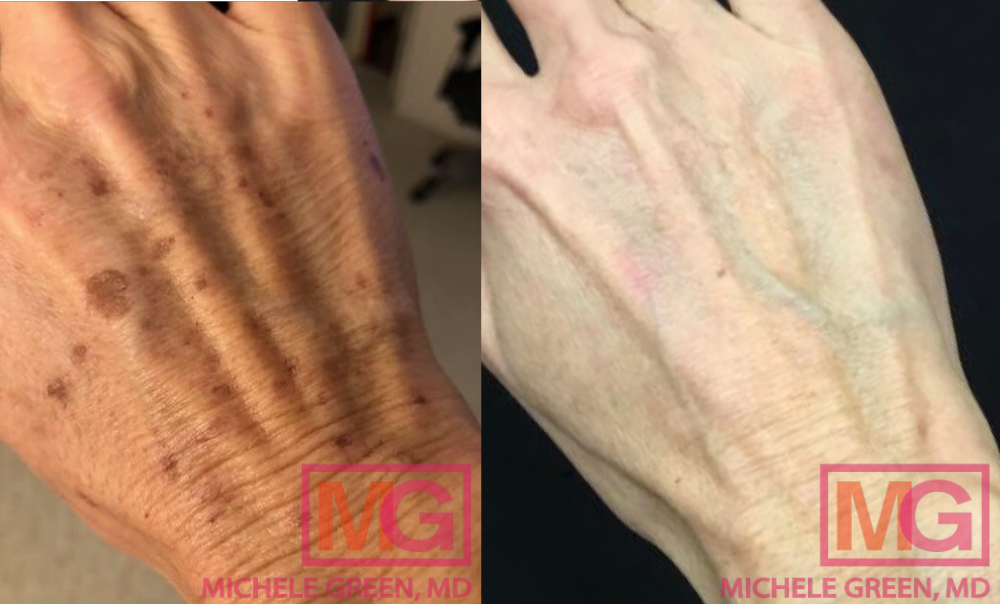
How to get started with removing sunspots today
The presence of sunspots can cause one to appear much older than one’s true age and, for many, cause feelings of self-consciousness or low self-esteem. Luckily, cosmetic dermatology has come a long way in developing new, innovative treatments for treating sunspots and pigmentation. Sunspots can be treated anywhere on the body, including but not limited to the face, neck, décolletage, hands, arms, legs, and back. Treatment is easy, safe, effective, and permanent as long as proper sun protection is practiced. Whether it’s a laser treatment or chemical peel, Dr. Green offers many non-invasive treatments for eliminating sunspots and creating beautiful, healthy, even-toned skin.
With over 25 years of experience, Dr. Michele Green has treated some of the world’s most discerning men and women for sunspot removal with treatments such as the Fraxel laser and Cosmelan peel. Due to her dedication to her patients, she is consistently voted as one of the best physicians in New York by Castle Connolly, Super Doctors, New York Magazine, and The New York Times. When you consult with Dr. Green, she will work with you to thoroughly understand your specific skin concerns and ideal cosmetic results and develop a treatment plan that incorporates a unique combination of in-office procedures and specially formulated skin care products. Whether you are looking to reduce the appearance of hyperpigmentation associated with sun damage, freckles, or sun spots or otherwise rejuvenate your skin, Dr. Green can help. To develop your personalized treatment plan for sunspot removal and consult with Dr. Green, call the New York City-based office at 212 535 3088 or contact us online today.
 212-535-3088
212-535-3088 